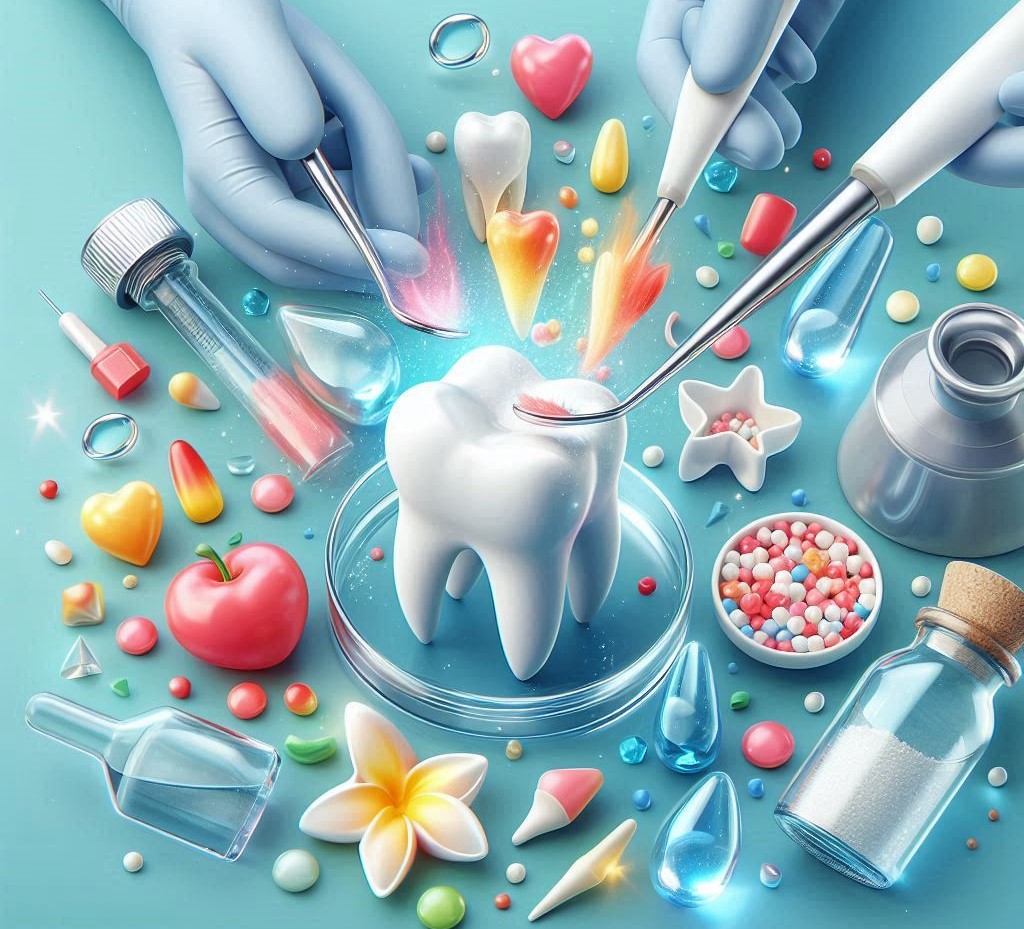Resin-based fillings, also known as composite fillings, are a modern solution for repairing cavities and restoring damaged teeth. Unlike traditional amalgam fillings made from a mixture of metals, resin-based fillings are composed of synthetic resins that are often mixed with other materials like silica, glass, and quartz to form a durable and tooth-colored filling material. Their primary advantage lies in their ability to blend seamlessly with natural teeth, making them an aesthetically superior option for visible areas, particularly in the front teeth.
Overview of Their Popularity in Modern Dentistry
Over the past few decades, resin-based fillings have become one of the most commonly used types of dental restorations. This shift can be attributed to advancements in dental technology, the growing desire for more natural-looking dental solutions, and the increasing awareness of the potential risks associated with other materials, such as mercury-based amalgam fillings. Resin fillings have gained widespread popularity among both dentists and patients due to their versatility, aesthetic appeal, and improved bonding properties, which help in preserving the structure of the tooth. The purpose of this detail is to provide a detailed exploration of resin-based fillings. From their composition to their application, advantages, and disadvantages, this guide aims to provide both dental professionals and patients with comprehensive knowledge about resin-based fillings. We will explore how these fillings work, their different types, uses, and how they compare to alternative materials. Additionally, we will delve into common concerns such as safety, cost, and longevity, helping readers make informed decisions about their dental care.
What are Resin-Based Fillings?
Resin-based fillings are dental restorations used to treat cavities and other types of tooth decay. The term “resin” refers to the synthetic, tooth-colored material used to fill the space left by the decayed tooth. These fillings are often favored for their ability to blend in with the natural color of teeth, unlike traditional silver amalgam fillings, which can be visible when patients smile or speak.
Composition and Types of Resin Fillings
Resin fillings come in several variations, each suited for different dental needs and patient preferences. Here’s a breakdown of the main types:
- Composite Resins: These are the most common type of resin fillings. They are composed of a mixture of plastic resin and fine glass particles. The plastic base provides the material with its flexibility, while the glass or quartz particles give it strength and durability.
- Glass Ionomer Resins: These are a type of resin that includes silicate glass particles and polyacrylic acid. Glass ionomer resins release fluoride, which can help in protecting the tooth from future decay. While they are not as strong or durable as composite resins, they are often used in fillings for areas that do not experience heavy chewing forces, such as cavities in baby teeth or in areas less visible to the eye.
- Resilon: A newer resin-based material, Resilon is primarily used in endodontic (root canal) therapy. It is a thermoplastic root canal filling material, which, unlike traditional gutta-percha, uses resilon-based materials to seal the root canal space.
How Resin Fillings Work
The resin used in these fillings is soft and moldable when first applied, allowing the dentist to shape it precisely to fill the cavity. Once placed, the filling is hardened using a special light (UV or LED light) that activates a chemical curing process. This process is often referred to as “curing,” and it transforms the resin into a hardened, durable material that matches the natural structure and appearance of the tooth.
Resin-based fillings are typically bonded directly to the tooth structure, making them more secure and reducing the chance of future decay forming beneath the filling. This bonding property is one of the main advantages of resin fillings over older filling materials like amalgam, which do not bond chemically to the tooth.
Materials Used
- Acrylic Resins: These resins are the most basic form of dental resin. They are soft and pliable, often used for temporary fillings.
- Methacrylate-Based Resins: These resins are more durable and are commonly used for long-term fillings. They include materials like bis-GMA (Bisphenol A-glycidyl methacrylate) and other monomers that provide strength and resilience.
- Silica and Quartz Particles: These are added to resins to enhance their strength, wear resistance, and overall durability.
History and Evolution of Resin Fillings
Development of Resin Fillings Over Time
The use of resin-based fillings in dentistry has undergone significant development since its inception. The earliest versions of resin materials were introduced in the 1960s, but they had limited success due to issues with durability, bonding, and wear resistance. Initially, resins were mainly used for cosmetic purposes, such as filling cavities in visible areas like the front teeth.
However, advancements in chemical formulation and resin technology allowed manufacturers to improve the physical properties of these materials. The 1980s marked the beginning of more widespread use as dentists began to recognize the potential of resins not only for their aesthetic advantages but also for their superior bonding capabilities. This led to increased use in a wider range of dental applications, including posterior teeth, which are subject to heavier chewing forces.
In the early 2000s, improved versions of resin materials were developed, offering even better strength, durability, and resistance to wear. Today, resin-based fillings are a standard treatment for cavities, offering a blend of aesthetics and functionality that was previously unattainable with materials like amalgam.
Key Milestones in Their Improvement
- 1980s: The introduction of better composite resins with improved bonding agents led to greater clinical success, especially for anterior teeth.
- 1990s: The development of more advanced curing lights (e.g., LED and halogen lights) enhanced the efficiency and precision of resin curing, making the process faster and more reliable.
- 2000s and Beyond: Innovations in nano-technology and the use of highly refined fillers (nano-fillers) resulted in even stronger and more durable resin fillings. These materials exhibit reduced shrinkage and improved longevity.
How Resin Fillings Became Mainstream in Dentistry
As research into dental materials progressed, the dental community gradually shifted away from metal-based fillings (like amalgam) in favor of resin-based alternatives. This transition was largely driven by the desire for more aesthetic solutions, as well as the growing awareness of the potential health concerns related to amalgam fillings, particularly their mercury content.
Furthermore, as the longevity and performance of resin fillings improved, they became more viable for use in both aesthetic and functional applications. With the added benefits of better adhesion and lower risk of further decay, resin fillings quickly became the material of choice for many dental professionals and patients alike.
Types of Resin Fillings
Composite Resins
Features and Benefits: Composite resins are a popular choice in restorative dentistry due to their excellent esthetics, versatility, and durability. These materials are often used to restore cavities in both front and back teeth, making them ideal for patients looking for natural-looking results.
Applications and Uses: Composite resins are highly versatile and can be used for a variety of dental treatments, including:
- Restoring cavities (both posterior and anterior)
- Repairing chipped or fractured teeth
- Filling gaps between teeth
- Cosmetic bonding (to improve the appearance of misaligned or discolored teeth)
Advantages:
- Tooth-colored and blend seamlessly with natural teeth.
- Can be easily sculpted to match the natural contours of the tooth.
- Minimal removal of healthy tooth structure is required.
Glass Ionomer Resins
Features and Benefits: Glass ionomer fillings contain a blend of glass and acrylic, offering a more economical alternative to composite resins. While not as durable or aesthetically pleasing, they are known for their fluoride-releasing properties, which can help protect teeth from further decay.
Applications and Uses:
- Best suited for fillings in non-aesthetic areas, such as molars or primary (baby) teeth.
- Ideal for areas with low chewing forces.
- Often used in pediatric dentistry and for temporary fillings.
Advantages:
- Fluoride-releasing properties can help prevent future decay.
- Bonds well to tooth structure.
- Can be a good choice for fillings in baby teeth, where aesthetics are not as critical.
Resilon
Features and Benefits: Resilon is a newer, more advanced resin material that is primarily used in root canal therapy. Unlike traditional materials like gutta-percha, Resilon is a thermoplastic filling material that can adapt to the root canal space, creating a more complete seal.
Applications in Root Canal Therapy:
- Resilon is used to fill the space left behind after the pulp of the tooth has been removed in root canal therapy. It’s considered a more flexible and longer-lasting alternative to traditional root canal filling materials.
Advantages:
- More adaptable to the shape of the root canal.
- Offers better sealing properties, reducing the risk of bacterial reinfection.
- Has some degree of antibacterial properties, which help prevent reinfection.
How Resin Fillings are Applied
The application of resin fillings involves a multi-step process. Here is a typical step-by-step procedure for composite resin fillings:
- Preparation of the Cavity: The dentist first removes any decayed tissue from the cavity. Unlike traditional fillings that may require extensive removal of healthy tooth structure, resin fillings require minimal tooth preparation.
- Bonding: A bonding agent is applied to the cleaned and dried cavity. This agent helps the resin adhere to the tooth surface, ensuring a stronger, more durable filling.
- Layering the Resin: The composite resin is applied in layers. Each layer is carefully sculpted to fit the cavity. The dentist ensures that the shape and structure of the tooth are restored to match the natural contours.
- Curing: Each layer of resin is cured using a special UV or LED light. This hardens the resin and allows it to bond to the tooth structure.
- Shaping and Polishing: Once the final layer is applied and hardened, the filling is shaped and polished to ensure a smooth, natural-looking finish. The dentist may also check the patient’s bite to make sure the filling does not interfere with normal chewing.
Comparing Resin Fillings to Other Types of Fillings
When compared to traditional materials like amalgam, resin fillings have clear advantages in terms of aesthetics and bonding. However, they may not be as durable or long-lasting as ceramic or metal-based fillings in some cases. The choice between resin and other filling materials depends on the location of the cavity, patient preference, and the size of the restoration.
Advantages of Resin-Based Fillings
Aesthetic Appeal
One of the main reasons patients choose resin-based fillings is their ability to blend with the natural color of the tooth. This is especially important for fillings in visible areas, such as the front teeth. Resin fillings can be matched to the natural color and shade of your teeth, making them virtually invisible.
Minimal Tooth Preparation
Unlike amalgam fillings, which often require the removal of healthy tooth tissue, resin fillings can be bonded directly to the tooth structure. This process helps preserve more of the natural tooth, reducing the need for extensive drilling.
Strength and Durability
Modern composite resins are highly durable and resistant to wear and tear, making them suitable for use in both anterior and posterior teeth. With proper care, resin fillings can last many years without significant damage.
Better Bonding
Resin-based materials bond directly to the tooth surface, creating a tight seal that helps prevent future decay. This adhesion prevents gaps between the tooth and the filling, reducing the risk of bacterial infiltration.
Healthier Option
Unlike amalgam fillings, which contain mercury, resin fillings are considered a safer and more biocompatible option. Resin fillings do not release harmful metals or chemicals into the body.
Disadvantages and Limitations of Resin Fillings
Potential for Wear and Tear
Resin fillings are not as durable as materials like porcelain or amalgam in terms of long-term wear, especially in areas that experience heavy chewing forces (e.g., molars). They can become worn or chipped over time, especially in high-pressure areas.
Sensitivity to Temperature Changes
Resin fillings may be sensitive to temperature fluctuations. For some patients, extreme temperatures can cause discomfort when eating or drinking hot or cold substances.
Higher Cost
While resin fillings are more aesthetically pleasing and versatile, they tend to cost more than amalgam fillings due to the materials and the technique involved in their application. This can be a factor for patients seeking more affordable options.
Possibility of Staining
Although composite resins are designed to resist staining, they are still susceptible to discoloration from certain foods, drinks (e.g., coffee, tea, red wine), or smoking. Over time, resin fillings may lose their initial luster.
Need for Maintenance and Replacement
Resin fillings, particularly those in high-stress areas, may require maintenance or replacement after several years. They tend to have a shorter lifespan than other materials, especially if they are exposed to significant wear.
The Lifespan of Resin-Based Fillings
Resin fillings generally have a lifespan of 5 to 10 years depending on various factors such as the location of the filling, the size of the cavity, and the patient’s oral hygiene habits. Fillings in the back teeth (molars), which undergo more pressure during chewing, may need to be replaced sooner than fillings in the front teeth.
How to Prolong the Life of Resin Fillings
To ensure the longevity of resin fillings, it is essential to maintain good oral hygiene practices, such as brushing twice a day, flossing regularly, and avoiding hard or sticky foods that could damage the filling. Regular dental check-ups are also important to monitor the condition of the fillings.
When to Replace Resin Fillings
Resin fillings may need replacement if they become worn, stained, or damaged. It’s important to address any issues early to prevent further damage to the tooth.
The Cost of Resin-Based Fillings
The cost of resin fillings can vary significantly depending on the location, size of the filling, and geographic location of the dental practice. On average, composite fillings can range from $100 to $250 per tooth. Larger fillings or fillings in posterior teeth may be more expensive due to the time and materials required.
Factors Influencing the Cost of Resin Fillings
- Location of the Filling: Fillings in the back teeth often cost more due to their larger size and more complex placement.
- Insurance: Many dental insurance plans cover the cost of resin fillings, but they may require the patient to pay a portion of the bill.
Insurance Coverage and Affordability Considerations
Dental insurance coverage for resin fillings may vary, and some plans may cover a larger portion of the cost for fillings in non-aesthetic areas (e.g., molars). Patients should check with their insurance provider to understand what is covered
Uses of Resin-Based Fillings
Resin fillings can be used for a variety of dental procedures. Some of the most common uses include:
- Restoring Cavities and Decay: Resin fillings are widely used to restore cavities in both anterior and posterior teeth.
- Aesthetic Restoration: Resin fillings can be used to improve the appearance of teeth that are chipped, cracked, or discolored.
- Pediatric Dentistry: Resin fillings are ideal for use in children’s teeth, as they offer an aesthetically pleasing option without the concerns associated with metal fillings.
- Orthodontic Applications: Resin can also be used in orthodontic procedures to bond brackets to the teeth or fill gaps during the treatment.
Safety Concerns and Health Considerations
Are Resin Fillings Safe for Long-Term Use?
Yes, resin fillings are considered safe for long-term use. They do not contain mercury like amalgam fillings and are generally well-tolerated by most patients.
Possible Allergies and Sensitivities
Some individuals may have allergies or sensitivities to certain components in resin-based fillings, particularly the bonding agents or the resins themselves. It’s important to inform your dentist of any known allergies before the procedure.
Concerns Regarding Bisphenol A (BPA)
Resin fillings may contain small amounts of BPA (Bisphenol A), a compound that has been linked to health concerns in certain individuals. However, the amount of BPA present in resin fillings is minimal and generally considered safe. Dentists often choose BPA-free options to address these concerns.
Alternatives to Resin Fillings
While resin-based fillings offer many advantages, they are not the only option available. Alternatives include:
- Amalgam Fillings: Durable and affordable but less aesthetic.
- Ceramic Fillings: Tooth-colored and highly durable but more expensive.
- Porcelain Restorations: Great for large cavities or cosmetic restorations but costly.
Future Trends in Resin-Based Fillings
As technology continues to advance, we can expect further improvements in the materials used for resin fillings. Researchers are exploring more eco-friendly options and developing biocompatible resins that could potentially offer greater durability and fewer health risks.
Conclusion
Resin-based fillings are a versatile and aesthetic option for patients seeking tooth restorations. With their ability to blend with natural tooth color, their durability, and their adhesive properties, resin fillings have become a cornerstone in modern dentistry. However, as with any dental treatment, it’s important to weigh the benefits and limitations when deciding if resin fillings are right for you. Regular dental check-ups and proper oral care can ensure that your resin fillings continue to serve you well for years to come.
SOURCES
Berg, J. H. (2019). Dental materials: Properties and applications in clinical practice. Elsevier.
Brezniak, N., & Rotstein, I. (2001). Resin-based root canal sealers: A review of the literature. Journal of Endodontics, 27(5), 324-332.
Bryant, R. W., & Robinson, S. (2017). Clinical applications of dental composites. Journal of Prosthodontic Research, 61(2), 90-96.
Ghasemi, A., & Azari, A. (2021). A review on the composition and applications of dental composites. Journal of Esthetic and Restorative Dentistry, 33(3), 247-254.
Leinfelder, K. F. (2007). Advances in the use of composite resin for restorative dentistry. Compendium of Continuing Education in Dentistry, 28(8), 422-433.
McLaren, E. A. (2015). Resin-based composite restorations: Evolution of materials, techniques, and the application in posterior teeth. Journal of the California Dental Association, 43(1), 12-17.
Morrison, R., & Cho, S. (2016). The impact of dental composite resins on restorative dentistry: A systematic review. Journal of Dental Research, 95(5), 525-531.
Rosenstiel, S. F., & Land, M. F. (2016). Contemporary fixed prosthodontics (5th ed.). Elsevier.
Wang, X., & Wang, Y. (2018). Dental materials and techniques in restorative dentistry: A comprehensive review. Dental Materials Journal, 37(2), 215-229.
White, S. N., & Harrison, J. D. (2002). Aesthetic considerations in restorative dentistry. Journal of Prosthetic Dentistry, 87(5), 476-482.
Xie, D., & Wu, S. (2019). The development of resin-based composites and the influence of material properties on clinical performance. Dental Materials, 35(6), 781-790.
HISTORY
Current Version
March 1, 2025
Written By:
SUMMIYAH MAHMOOD




